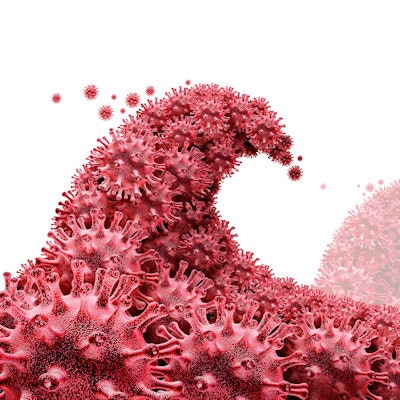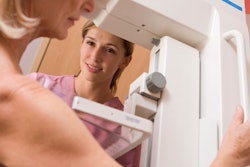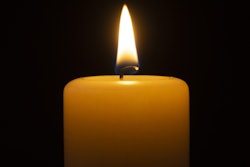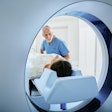
It's likely that there will be a second wave of COVID-19 illness going into the autumn and winter, and breast imaging specialists must continue to be proactive in planning for it, according to a report published on 1 September in the European Journal of Radiology Open.
Anticipating a second round of the pandemic is crucial for the safety not only of patients but also of breast imaging staff, who are vulnerable to infection due to close patient contact, wrote a team led by Dr. Trishna Shimpi of Women's College Hospital in Toronto and Khoo Teck Puat Hospital in Singapore.
"The World Health Organization (WHO) affirms that in some countries, one in 10 healthcare workers is expected to be infected with the coronavirus," the group wrote. "Two mammography technologists reportedly died of COVID-19 in March 2020, the first two medical personnel deaths recorded in the [U.S.] state of Georgia due to the disease."
Dire effects
Since the COVID-19 pandemic hit, it has affected healthcare workers: In fact, of the first 4,672 cases in China, 1,716 were healthcare workers, and of these, 14.8% were severe or critical cases. As of April of this year, one in 10 COVID-19 cases was a healthcare worker; in the U.S. in April, almost 10,000 healthcare workers had confirmed COVID-19, and in Italy, 17,000 contracted the disease.
Workers in breast imaging services have a higher risk of contracting and passing COVID-19 pneumonia, since it involves close patient contact, from preparing women for the exam to acquiring images to performing interventional or diagnostic procedures. In response to COVID-19, some facilities have delayed breast cancer screening exams and diagnostic procedures.
In their report, Shimpi and colleagues described how how three Canadian hospitals (Princess Margaret, Sinai Health System, and Women's College) handled breast imaging during the initial phase of the pandemic, and highlighted key issues departments must continue to address in anticipation of a second surge of disease.
Setting priorities
The hospitals created internal task forces shortly after the WHO declared COVID-19 a pandemic in March. These committees developed a scale to prioritize the scheduling of breast imaging exams based on patient risk, referring to guidance issued by Ontario Health, the American College of Radiology, the American College of Surgeons, and the Society of Breast Imaging. Priority categories included the following:
- A. Patients who require services and/or treatment even during the pandemic because their condition is unstable or immediately life threatening. "These patients include emergency patients with acute onset of infectious symptoms, suspected breast abscess imperative for diagnosis and drainage as well as patients in whom a delay in surgery would result in either an immediate threat to life or would significantly alter the patient's prognosis," the authors noted.
- B. Patients who require services but whose condition is not critical. "These patients are those with breast symptoms or imaging-detected lesions classified as BI-RADS 4 or 5," the group wrote.
- C. Patients who are overall healthy and for whom the service can be delayed without any anticipated changes in health outcome (screening, both mammography and MRI; recalled patients whose results were deemed likely to be benign; and BI-RADS 3 lesion follow-up).
The group decided to continue to offer diagnostic imaging studies and image-guided interventions (percutaneous biopsies and preoperative localizations) on a case-by-case basis to patients in the categories A and B. But handling patients in category C was trickier, corresponding author Dr. Vivienne Freitas told AuntMinnieEurope.com via email.
"The most challenging situation was in healthy patients classified as category C, with findings on screening mammography, to accurately consider the lesion as probably benign without the necessary workup and, therefore, to postpone [follow-up] until after the pandemic plateau," she said. "In fact, BI-RADS lexicon does not recommend [this delay] in screening situations, given the possibility of potentially harboring a hidden malignancy that mimics a benign lesion or a cancer with an unusual appearance."
Women in categories A and B were prescreened at the hospital for COVID-19 symptoms and travel history; if a patient failed to clear this prescreening, he or she was directed to the hospital's COVID-19 assessment center. All breast imaging staff wore appropriate personal protective equipment (PPE) and surgical face masks. Patients were also required to wear a mask.
The hospitals also adopted the following measures:
- Minimizing the number of staff per site, including radiologists
- Minimizing movement of staff across hospital sites
- Establishing an "if needed" backup staff list
- Modifying waiting rooms, hallways, and changing areas to minimize interaction with patients
- Establishing support resources for staff such as mental health counseling and online learning tools such as fitness and mental health classes
These efforts have proven successful, according to the team.
"So far, the operational measures reviewed here have proven to be effective to limit transmission and efficiently run breast imaging services at our department over the last three months, as there have been no patient-related infection encountered in any of the staff across all sites (including medical, paramedical, and clerical staff), and hence, can be used as a basic operational framework to build upon for other breast imaging departments," the group wrote.
Going forward
The course of the COVID-19 pandemic remains unclear, and breast imaging departments must anticipate how they will cope with a second wave of illness. Particularly, departments must ensure that they have adequate PPE, the authors cautioned.
"Though the [PPE] supply was adequate in our province and set up through the initial phase of this first wave of the COVID pandemic, it is to be noted that there has been a global shortage of PPE stocks and hence rational and prudent use of PPE is of utmost importance in case of a second wave of the pandemic," they wrote.
Coping safely with the COVID-19 pandemic will also fuel discussion over breast cancer screening intervals, according to Freitas.
"A second wave of COVID may prompt an even longer screening interval for breast imaging, which could negatively impact cancer screening, particularly for high-risk patients," she said.



















